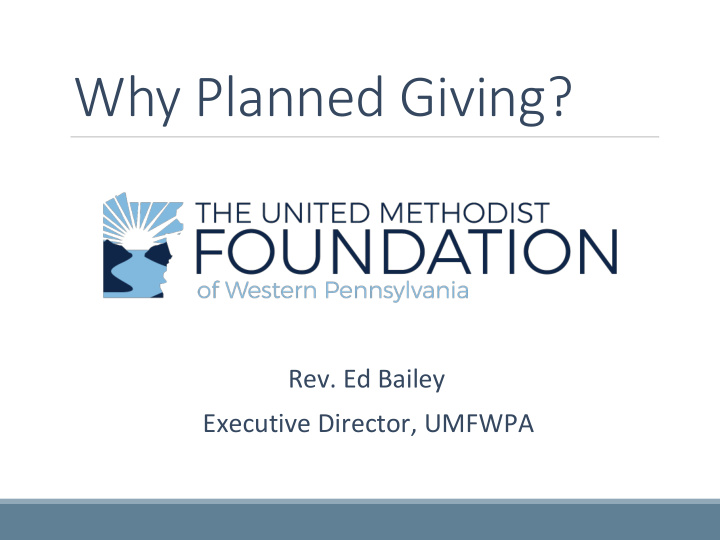



Why Planned Giving? Rev. Ed Bailey Executive Director, UMFWPA
Three Areas to Discuss: • Today’s giving environment • What planned giving is and the need for it • How to incorporate planned giving in your church
Setting the Stage People have a need to give that is greater than the need of an organization to receive
Setting the Stage 1. Created in the image of God
Setting the Stage 2. God is Giving
We Are Called To Be Good Stewards • “The earth is the Lord’s and everything in it, the world and all who live in it.” – Psalm 24:1 • “…every animal of the forest is mine and the cattle on a thousand hills.” – Psalm 50:10
The Challenge Local Churches Face • Giving is decreasing • Costs are increasing • Congregations are aging
Today’s Charitable Giving Environment o Charitable giving has increased every year since 1971, with the exception of three: 1987, 2008, and 2009. o 2019 was the tenth year individual giving has increased.
Today’s Charitable Giving Environment
Religion Giving is Declining...
The Need for Planned Giving According to latest estimates by Boston College’s Center on Wealth and Philanthropy, charities are expected to receive $27 trillion in planned gifts by 2061. While Religion receives about 29% of all charitable giving, it only receives about 10% of estate gifts. So why Planned Giving? Much of the intergenerational transfer will be accomplished through planned giving.
Defining Planned Giving • In the past, planned giving was often called “deferred giving.” However, not all planned gifts are deferred. • Planned Giving is any gift that requires a professional. • Another thought – switch the words: think about it as “gift planning.” • Gifts can be planned: • Now or in the future • They may involve a person’s estate • Usually involves giving beyond cash
Defining Planned Giving Planned giving is also a statement of belief. Look at this definition as noted in The Planned Giving Blog : “…planned giving [occurs] when the values of an institution align with a donor’s own values to the extent that it becomes the donor’s belief that these values should be preserved for the future.”
Defining Planned Giving BENEFITS for the individual who wants to support. In addition to supporting the ministry/institution, planned giving offers several benefits which may include: • Income for life • Reducing taxes • Providing for loved ones • “Passing on a legacy”
Let’s Define Planned Giving: BENEFITS for the organization. The largest gifts that most organizations will receive are from planned gifts.
With All of These Benefits WHY is it that many churches have never received , or received only a few , planned gifts?
Planned Giving as a Stewardship Concept He said to them, “Cast the net to the right side of the boat, and you will find some.” So they cast it, and now they were not able to haul it in because there so many fish.” – John 21:6
So… Why Planned Giving? THE BIBLE SPEAKS ABOUT IT! And Joses, who was also Barbabas gave generously of his life and substance for the named Barnabas by the encouragement of the apostles apostles (which is translated and their ministry. Son of Encouragement), a Today, we have the opportunity Levite of the country of to follow his example in lives Cyprus, having land, sold it, given to charity and the and brought the money and proclamation of the Gospel; through Christ our Lord. laid it at the apostles’ feet.” – Acts 4:36-37
Define the Ministry Given the ministries that you have stated: • All, one, or a few… should the program be broadly or narrowly focused? • What are the benefits of each approach? Each church is unique… Each approach will be different
Creating Options for Support This is where the use of an endowment fund is prescribed. To illustrate why, let’s look at the example of the Smith Family and their desire to save for their children’s education…
Communication How do you communicate the initial idea to the church? • Pastoral announcements • Formal programs • Bulletin inserts • Resource tables • Social media Utilize existing methods
Gift Development The Foundation can help you work with donors to: • Identify opportunities • Structure agreements • Save money and time • Bless their family/church Encourage individuals to consult with their families and independent advisors.
Donor Recognition Recognition can be the missing piece to the puzzle. Ways to honor donors: • Let them tell their story – testimonies inspire ! • Plaques and Certificates • Verbal recognition • Formal Legacy Society Support becomes contagious – having the potential to strengthen a culture of generosity with your church.
Ongoing Program Evaluation Continue to monitor and improve the program over time! • Be committed • Try new strategies • Be flexible • Continue to learn and grow
UMFWPA Can Help • “Pass It On” legacy program • Templates for local church endowment policies • Resource for questions • Funds management
Local Church Administration of Endowment Funds Endowment Committee Endowment Policy UM Discipline Permanent Responsibilities Options for Giving Resolution Accept or Reject Gifts Dedicated
Questions? We are here for YOU! We are here for YOU! Phone 412-232-0650 Fax 412-232-0675 Email info@umfoundation.org Website www.umfoundation.org Mail 223 Fourth Avenue, Suite 707 Benedum-Trees Building Pittsburgh, PA 15222
Recommend
More recommend